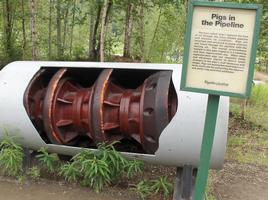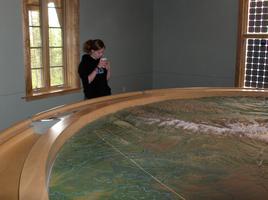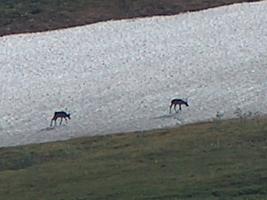Travel Journal: (Alaska; Fairbanks, Denali) |
 Cruising a river with 900 closest tourist
friends....
Cruising a river with 900 closest tourist
friends....The Riverboat Discovery is one of the main tourism draws in the area. This attraction is a paddle wheel driven riverboat that holds about 900 people on 4 decks. Over 3.5 hours of time on the river, the boat pauses in the river at a few attractions and stops at another to teach something culture in the area. Along the way, they also talk about the houses in the area, costs, type of ways to insulate, who has lived or stayed in them and so forth.



The first stop is at a kennel run
by Susan Butcher (the 4 time winner of the Iditarod) and her husband.
They talk about raising sled dogs and show a team of dogs pulling
a modified 4 wheel ATV over about a half mile loop.  At
the place where the Chena River meets the Tanana river, the boat
explainer person talks about the differences in the amount of
silt in the two rivers.
At
the place where the Chena River meets the Tanana river, the boat
explainer person talks about the differences in the amount of
silt in the two rivers.  Next
pause is at a native fishing camp showing how they fished using
fishing wheels, and they gave a demonstration on preparing a fish
for drying. The last stop was at a village of multiple talks on
how the natives live in the area, some of their crafts, and another
talk about the sled dogs.
Next
pause is at a native fishing camp showing how they fished using
fishing wheels, and they gave a demonstration on preparing a fish
for drying. The last stop was at a village of multiple talks on
how the natives live in the area, some of their crafts, and another
talk about the sled dogs.
While they have a captive audience on the boat, for selling things, the prices weren't too bad and the food was very reasonable. We had some Reindeer sausages and drinks. The guy explaining things while traveling on the boat was very knowledgeable and entertaining. Overall this was a worthwhile afternoon even though it was $45 each (one person was free with the toursaver coupon).
The El Dorado Gold mine makes a
lot of money by mining the wallets of tourists. For $30 (can use
a toursaver coupon for one free admission) , you get to ride a
little train around a loop, stopping to see what a mine tunnel
in permafrost would look like, another piece of equipment for
bringing  material
up out of a mine, how a long sluice box and panning works, and
do some panning of a small amount of dirt containing some gold
flakes. The conductor person explained things while the train
was in motion and was very entertaining. He also played the fiddle
very well. It was probably worth it overall.
material
up out of a mine, how a long sluice box and panning works, and
do some panning of a small amount of dirt containing some gold
flakes. The conductor person explained things while the train
was in motion and was very entertaining. He also played the fiddle
very well. It was probably worth it overall.
"Panning" of gold was fun to do. This was partly due to the fact that they used soil guaranteed to contain some gold. The water in this area for the tourists to do the panning was in troughs and heated, so it was pleasant to do too. Once you were done "panning" the gold, they had a place you could have it weighed and they gave an estimate of it's worth based on current gold market rates. According to the guy weighing ours, the average person gets about $6 to $8 of gold. In our case, Sara got $34 worth, and Sandi and Jerry had about $12 each. Now the real mining is done by the helpers in the jewelry shop. For a moderate price you can have your gold placed in a locket with a gold chain. Overall, we ended up only spending $110 for $58 of gold, lockets, chains and the tour. It was still worth it.

The University of Alaska museum is a typical museum of culture, wildlife, geography, geology, and so forth. It is a good place to learn a lot about this area past and present. Currently the exhibits are tightly situated in a large room. They are working on expanding this building so it might be a little easier to view the exhibits in the future.
 The oil pipeline comes through the area
from the north slope on it way to Valdez. This pipeline is only
48" in diameter and contains multiple layers for thermal
and support reasons.
The oil pipeline comes through the area
from the north slope on it way to Valdez. This pipeline is only
48" in diameter and contains multiple layers for thermal
and support reasons.  They
place "pigs" (plastic scraper things) inside the pipeline
to scrape it and keep the oil flowing well. The other interesting
part of all this is the efforts in the construction used to keep
the oil from warming up the permafrost. If the permafrost was
allowed to thaw, then the pipeline would lose it's structural
support.
They
place "pigs" (plastic scraper things) inside the pipeline
to scrape it and keep the oil flowing well. The other interesting
part of all this is the efforts in the construction used to keep
the oil from warming up the permafrost. If the permafrost was
allowed to thaw, then the pipeline would lose it's structural
support.



Our stay in the Denali area, was mostly dealing with scattered showers. It was cool and wet, which "dampens" the stay some. The clouds were constant around the mountains, with only patches of clearing in the valleys. The park has a very nice visitor center, which was completed this year.


This park doesn't get as many visitors as the larger parks in the continental states, like Yellowstone, Glacier, Rocky Mountain, and so forth, so that is a relief. There is only one road into the park and most of that road is accessible only by shuttle buses and tour buses.






The only way to see wildlife in this park is to take one of the buses on the road that goes into the park. Individual cars may only go about 12 miles into the park. These buses stop at any sighting of wildlife. With 48 sets of eyes, the bus driver listens for anyone yelling "Stop!", then pulls over to see what the person thinks the see. The animals don't cooperate much and were often just specs on a far hill. These were the larger animals and included Dahl Sheep, some grizzly bears, and caribou (reindeer). We also saw some smaller animals closer to the road like fox, marmots, ptarmigan, squirrels, etc. We did not see moose, or wolves. They must have had the day off.
Hikers use the shuttle buses to
get to various places to hike. Near the visitor center there are
groomed trails to hike on, however after that, there are no established
trails. Since there are so few hikers, they can just walk where
ever they want to, with a few exceptions. There are some areas
that are marked as do not enter. These are for known nesting areas
and similar places.  You
also are warned to not get within certain distances of various
animals, such that you don't disturb them. If we had more time
and better weather, this might have been a good way to experience
this park. (That's true of about any national park, walk a quarter
mile and you will be away from most of the human visitors.)
You
also are warned to not get within certain distances of various
animals, such that you don't disturb them. If we had more time
and better weather, this might have been a good way to experience
this park. (That's true of about any national park, walk a quarter
mile and you will be away from most of the human visitors.)
We found this bit about mosquitoes to be somewhat amusing. Maybe we need to think twice about swatting the little suckers. But then the driver of the shuttle bus had no problems swatting mosquitoes and recommending that others do that too. Maybe she didn't get the message in the visitor center. Personally, we will still be swatting them. As a side note, we have had very few problems with mosquitoes during this trip (other than at that one stop at Watson Lake on the way up the Alaska Highway). We have seen a few of them when out walking the dog in the evenings, but not felt like they were overwhelming nor felt that need to change what we were doing because of them.
 "Denali" is the Athabascan word
for "The Tall One" or "The High One". We just
can't come up with words that describe how tall this mountain
is, mostly because we never got to see it due to the clouds that
surrounded all the mountains while we were in the area. When we
were driving south past the park, on our way to Anchorage, the
clouds did part some and we saw a glimpse of what we think is
Mt McKinley / Denali. But we don't know for sure.
"Denali" is the Athabascan word
for "The Tall One" or "The High One". We just
can't come up with words that describe how tall this mountain
is, mostly because we never got to see it due to the clouds that
surrounded all the mountains while we were in the area. When we
were driving south past the park, on our way to Anchorage, the
clouds did part some and we saw a glimpse of what we think is
Mt McKinley / Denali. But we don't know for sure.
 Overall, the geography is interesting. The
stream beds are very wide, because of how the glaciers carved
the valleys. The streams don't ever fill the river beds up, but
due to the water wandering through the glacial gravel, cutting
different paths keeps the streambeds very wide, making the rivers
look wide. Due to the high latitude, the tundra starts at a very
low altitude, just a few thousand feet. This is where much of
the wildlife is seen, partly because they can't hide well there.
They also like these areas because they can see predators from
far away, too.
Overall, the geography is interesting. The
stream beds are very wide, because of how the glaciers carved
the valleys. The streams don't ever fill the river beds up, but
due to the water wandering through the glacial gravel, cutting
different paths keeps the streambeds very wide, making the rivers
look wide. Due to the high latitude, the tundra starts at a very
low altitude, just a few thousand feet. This is where much of
the wildlife is seen, partly because they can't hide well there.
They also like these areas because they can see predators from
far away, too.
While this is a very nice park to visit, it is probably much better to see when the weather is better. It looks like we will need to return to this place to see more wildlife and the mountains.